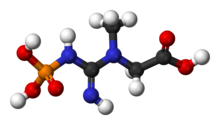Phosphocreatine

| |

| |
| Names | |
|---|---|
| IUPAC name
N-Methyl-N-(phosphonocarbamimidoyl)glycine
| |
| Other names
Creatine phosphate; phosphorylcreatine; creatine-P; phosphagen; fosfocreatine
| |
| Identifiers | |
3D model (JSmol)
|
|
| Abbreviations | PCr |
| ChemSpider | |
| ECHA InfoCard | 100.000.585 |
| EC Number |
|
PubChem CID
|
|
| UNII | |
CompTox Dashboard (EPA)
|
|
| |
| |
| Properties | |
| C4H10N3O5P | |
| Molar mass | 211.114 g·mol−1 |
Except where otherwise noted, data are given for materials in their standard state (at 25 °C [77 °F], 100 kPa).
| |
Phosphocreatine, also known as creatine phosphate (CP) or PCr (Pcr), is a phosphorylated creatine molecule that serves as a rapidly mobilizable reserve of high-energy phosphates in skeletal muscle and the brain.
Chemistry
Phosphocreatine is formed from parts of three amino acids: arginine (Arg), glycine (Gly), and methionine (Met). It can be synthesized by formation of guanidinoacetate from Arg and Gly (in kidney) followed by methylation (S-adenosyl methionine is required) to creatine (in liver), and phosphorylation by creatine kinase (ATP is required) to phosphocreatine (in muscle); catabolism: dehydration to form the cyclic Schiff base creatinine. Phosphocreatine is synthesized in the liver and transported to the muscle cells, via the bloodstream, for storage.
The creatine phosphate shuttle facilitates transport of high energy phosphate from mitochondria.
Function
Phosphocreatine can anaerobically donate a phosphate group to ADP to form ATP during the first 2 to 7 seconds following an intense muscular or neuronal effort. Conversely, excess ATP can be used during a period of low effort to convert creatine to phosphocreatine. The reversible phosphorylation of creatine (i.e., both the forward and backward reaction) is catalyzed by several creatine kinases. The presence of creatine kinase (CK-MB, MB for muscle/brain) in blood plasma is indicative of tissue damage and is used in the diagnosis of myocardial infarction.[1] The cell's ability to generate phosphocreatine from excess ATP during rest, as well as its use of phosphocreatine for quick regeneration of ATP during intense activity, provides a spatial and temporal buffer of ATP concentration. In other words, phosphocreatine acts as high-energy reserve in a coupled reaction; the energy given off from donating the phosphate group is used to regenerate the other compound - in this case, ATP. Phosphocreatine plays a particularly important role in tissues that have high, fluctuating energy demands such as muscle and brain.
History
The discovery of phosphocreatine[2][3] was reported by Grace and Philip Eggleton of the University of Cambridge[4] and separately by Cyrus Fiske and Yellapragada Subbarow of the Harvard Medical School[5] in 1927. A few years later David Nachmansohn, working under Meyerhof at the Kaiser Wilhelm Institute in Dahlem, Berlin, contributed to the understanding of the phosphocreatine's role in the cell.[3]
References
- ^ Schlattner, U.; Tokarska-Schlattner, M., and Wallimann, T. (2006). "Mitochondrial creatine kinase in human health and disease". Biochimica et Biophysica Acta - Molecular Basis of Disease. 1762 (2): 164–180. doi:10.1016/j.bbadis.2005.09.004. PMID 16236486.
{{cite journal}}: CS1 maint: multiple names: authors list (link) - ^ Saks, Valdur (2007). Molecular system bioenergetics: energy for life. Weinheim: Wiley-VCH. p. 2. ISBN 978-3-527-31787-5.
- ^ a b Ochoa, Severo (1989). Sherman, E. J.; National Academy of Sciences (eds.). David Nachmansohn. Biographical Memoirs. Vol. 58. National Academies Press. pp. 357–404. ISBN 978-0-309-03938-3.
- ^ Eggleton, Philip; Eggleton, Grace Palmer (1927). "The inorganic phosphate and a labile form of organic phosphate in the gastrocnemius of the frog". Biochemical Journal. 21 (1): 190–195. PMC 1251888. PMID 16743804.
- ^ Fiske, Cyrus H.; Subbarao, Yellapragada (1927). "The nature of the 'inorganic phosphate' in voluntary muscle". Science. 65 (1686): 401–403. doi:10.1126/science.65.1686.401. PMID 17807679.
